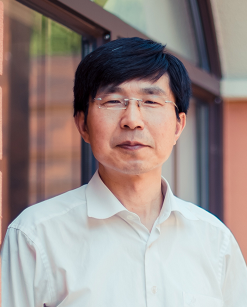 +565 975 658
+565 975 658
 info@premiumcoding.com
info@premiumcoding.com
 Monday - Friday, 8.00 - 20.00
Monday - Friday, 8.00 - 20.00
 Jiandong Ding
Jiandong Ding
Distinguished Professor
Director, State Key Laboratory of Molecular Engineering of Polymers
Room B3100, Chemistry/Macromolecular Building, Department of Macromolecular Science, Jiangwan Campus of Fudan University, Shanghai 200438, CHINA
Tel:+86-21-31243506
Email: jdding1@fudan.edu.cn
Homepage:www.polymer.fudan.edu.cn/polymer/research/dingjd/index.htm
Education and Working Experience
1983-1988 B.S., School of Life Sciences, Fudan University, China
1989-1991 M.A., Department of Material Science, Fudan University, China
1993-1995 Ph.D., Department of Macromolecular Science, Fudan University, China
1998-1999 Postdoctor, Department of Material Science, Cambridge University, UK
1991 Remain on the school staff after graduation, Fudan University, China
1998- Professor, Fudan University, China
1998 Winner of "Outstanding Young Scientist Foundation" by NSF of China
2009 Awarded as “Chang-Jiang Scholar Professor” by Ministry of Education
2009-2013 Chief Scientist of a National Program for Nano-biomaterials
2016-2020 Chief Scientist of a National Program for Biomaterials and Medical Devices
2016- Leading Scientist in National ‘Ten Thousands of Talents’ Program
2004-2011 Director, Key Lab of Molecular Engineering of Polymers of Ministry of Education of China,
2011- Director, State Key Laboratory of Molecular Engineering of Polymers
Research Interests
Polymeric biomedical materials
- Fundamental Investigation of Cell-Biomaterial Interaction
- Techniques of Tissue Engineering & Tissue Regeneration Materials
- Techniques of Sustained Release Carriers
Representative Publications
(1) Peng YM, Liu QJ, He TL, Ye K, Yao X, Ding JD*. Degradation rate affords a dynamic cue to regulate stem cells beyond varied matrix stiffness, Biomaterials 2018, 178: 467-480.
(2) Liu XN, Liu RL, Cao B, Ye K, Li SY, Gu YX, Pan Z, Ding JD*. Subcellular cell geometry on micropillars regulates stem cell differentiation, Biomaterials 2016, 111: 27-39.
(3) Ye K, Wang X, Cao LP, Li SY, Li ZH, Yu L, Ding JD*. Matrix stiffness and nanoscale spatial organization of cell-adhesive ligands direct stem cell fate, Nano Lett. 2015, 15(7): 4720-4729.
(4) Li X#, Zhang WQ#, Lin WJ, Qiu H, Qi YL, Ma X, Qi HP, He Y, Zhang HJ, Qian J, Zhang G, Gao RL*, Zhang DY*, Ding JD*. Long-term efficacy of biodegradable metal-polymer composite stents after the first and the second implantations into porcine coronary arteries, ACS Appl. Mater. Interfaces 2020, 12(13): 15703-15715.
(5) Yao X, Ding JD*. Effects of microstripe geometry on guided cell migration, ACS Appl. Mater. Interfaces 2020, 12(25): 27971–27983.
(6) Yao X, Liu RL, Liang XY, Ding JD*. Critical areas of proliferation of single cells on micropatterned surfaces and corresponding cell type dependence. ACS Appl. Mater. Interfaces 2019, 11(17): 15366-15380.
(7) Qi YL, Qi HP, He Y, Lin WJ, Li PZ, Qin L, Hu YW, Chen LP, Liu QS, Sun HT, Liu Q, Zhang G, Cui SQ, Hu J, Yu L, Zhang DY*, Ding JD*. Strategy of Metal-polymer Composite Stent to Accelerate Biodegradation of Iron-based Biomaterials, ACS Appl. Mater. Interfaces 2018, 10: 182-192.
(8) Cui SQ, Yu L, Ding JD*. Thermogelling of amphiphilic block copolymers in water: ABA type versus AB or BAB type, Macromolecules 2019, 52: 3697-3715.
(9) Cui SQ, Yu L, Ding JD*. Semi-bald Micelles and Corresponding Percolated Micelle Networks of Thermogels. Macromolecules 2018, 51: 6405-6420.
(10) Liang XY, Gao JM, Xu WK, Wang XL, Shen Y, Tang JY, Cui SQ, Yang XW, Liu QS, Yu L, Ding JD*. Structural Mechanics of 3D-printed Poly(lactic acid) Scaffolds with Tetragonal, Hexagonal and Wheel-like Designs. Biofabrication 2019, 11(3), art No. 035009 (pages 1-22).
Honors and Awards
- "First-class Prize for Natural Science Research” awarded by Ministry of Education
- Supervisor of “Excellent Ph.D Thesis” awarded by Shanghai Education Committee
- "Prize of Young Professors" awarded by Ministry of Education
- "Science and Technology Prize in Chinese Younger” by State Association for Science and Technology
Academic Service
-
“Excellent Product Award” for an injectable medical hydrogel by International Trade Fair of Techniques held in Shenzhen, China
- Fellow, Biomaterials Science & Engineering (FBSE), by International Union of Societies for Biomaterials Science & Engineering
- Committee Member of the Chinese Society for Biomaterials, CSBM
- Committee Member of Polymer Division, Chinese Chemical Society, CCS
- Director of Biophysical Society of China, BSC
- Director of Chinese Society of Micro-nano technology, CSMNT
- Deputy Editor-in-chief of Journal of Functional Polymers
- Editorial board member of Acta Polymerica Sinica
- Editorial board member of Regenerative Biomaterials (Proceeding of Chinese Society for Biomaterials, Oxford University Press)
- Advisory board of Macromolecules (American Chemistry Society)
- Advisory board of ACS Biomaterials Science and Engineering
- Invited reviewer for about 100 international journals such as
Nature Biomedical Engineering, Nature Communications, Biomaterials, Macromolecules, Journal of American Chemical Society.
Get to know us better now!

Wechat:FDUMMers
Search!
Search across our website
Revenant @ 2018 by fudan | All Rights Reserved
Powered by Weicheng

